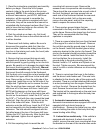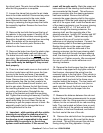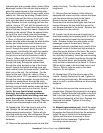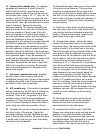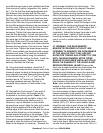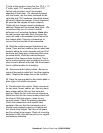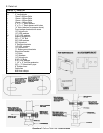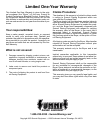Questions? Call our Tech Line 1-330-630-0240
26. 4-wheel drive models only: On vehicles
equipped with electronic 4-wheel drive shift
control (shift on the fly), wrap the wire loom
bracket (supplied in the kit) around the wires at
the transfer case. Using a 1/4" x 1" bolt, two 1/4"
washers, and a 1/4" Nylock nut mount the new
wire loom bracket to the stock bracket at the rear
of the transfer case. Be sure that there is ample
slack in the wires. Tighten the mounting
hardware securely. On vehicles equipped with
manual 4-wheel drive, check the 4-wheel drive
shift lever operation. Check to see if the shift
lever will engage in all 4-wheel drive ranges. If
the shift lever makes contact with the floorboard,
notch the floorboard to allow for complete
engagement in all 4-wheel drive ranges. Reinstall
the shift boot assembly. Check the shift lever
operation again. It may be necessary to modify
the boot assembly to allow for proper shift lever
operation. Mount the shift boot to the floorboard.
Reinstall the shift boot assembly. Check the shift
lever operation again. It may be necessary to
modify the boot assembly to allow for proper shift
lever operation. Mount the shift boot to the
floorboard. Reinstall the shift knob. Check both
shift levers' operation once more. Be sure that
there is ample engagement in all gears and 4-
wheel drive ranges.
27. Automatic transmission only: Reattach
the shift cable to the mounting clips on the
firewall/bed housing area. It may not be possible
to reattach the cable to all of the mounting tabs,
but attach it to as many as possible.
28. A/C models only: If the vehicle is equipped
with air conditioning, the A/C hose is rubbing on
the bottom of the alternator and needs to be
insulated. There is a 6" long piece of 3/4" hose
included in the kit. Split the hose lengthwise.
Place the 3/4" hose over the A/C hose between
the A/C hose and alternator. Secure the hose in
place using two cable ties provided in the kit.
29. Reinstall the wire loom mounting bracket to
the driver's side of the engine. Tighten the
mounting hardware securely. Reattach the wire
loom to the mounting bracket. Be sure that there
is ample slack in the wiring to reach the battery
and driver's side fenderwell.
30. Reinstall the sheet metal cover on the inside
of the driver's side frame rail. The large tube
should be routed between the top legs of the
cover. Be sure that there is ample slack in the line
and that it is not rubbing on anything that could
wear a hole in the line or hinder the operation of
any component. Tighten the cover's mounting
screws securely.
31. Check the brake lines that were removed
from the clips on the driver's side fender well. Be
sure that the lines have extended and are not
binding. If the lines are binding, carefully and
gently bend them to gain more slack.
32. Remount the radiator. Mount the rubber
cushion that the radiator sat on in the radiator
drop-down tubes. The nipple on the bottom of the
cushion should fit in the small hole in the tube.
The top of the tube will mount to the bottom of the
stock mount. Slide the tube with the cushion
around the arm on the radiator so the arm will sit
on the cushion. Mount the tube with the radiator
to the bottom of the stock radiator mount by
installing a 5/16" x 1" bolt and 5/16" large washer
from the top of the stock mount and screwing
down into the nut that is attached to the top of the
tube. Do not tighten. Mount the radiator drop-
down brackets to the core support where the
radiator was originally mounted. Mount the
radiator mount to the stud on the radiator bracket.
Install a 1/4" washer and Nylock nut on each
stud. Do not tighten. Adjust the fan-to-fan shroud
clearance. It should be the same all the way
around the radiator. Tighten all radiator mounting
hardware securely. We recommend the use of
Loctite® or similar adhesive on all mounting
hardware.
33. Reconnect the air intake hose to the air
cleaner assembly and the intake manifold.
Reconnect any wires or hoses that were
disconnected from the intake hose.
34. Lengthen the fuel filler hose. CAUTION:
Always use extreme care when working around
gasoline or any other flammable substance.
Gasoline is highly explosive and can ignite with
the slightest spark. Take precautions to prevent
any leakage of fuel while the filler neck is
disconnected. Fuel vapors can be harmful; be




